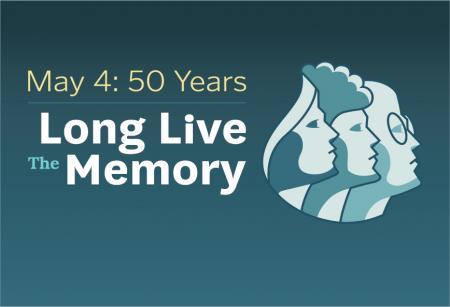Online Exhibits
THE MAY 4 AUGMENTED REALITY EXPERIENCE
The May 4 augmented reality experience is designed to engage and immerse users as they journey through the events of May 4, 1970, and reflect on its meaning for today. The experience invites users to view multiple perspectives of the Kent State shootings through the lens of augmented reality using historical imagery, audio and related experiences that highlight past and current humanitarian struggles. Visitors to Kent State's campus can explore multiple hotspots and see historical images in real time and locations. Users unable to visit the campus can explore those same audio and visual materials from any location using the application's 360 images of the Kent Campus. All users will have a chance to see and hear about the context leading up to May 4, 1970, events on the day of the shootings, yearly commemorations at the particular hotspot, and questions that promote voices for change.
MAPPING MAY 4
This web app draws from the oral histories in the May 4 Collection, Kent State Special Collections & Archives. It maps stories from those histories that describe memories of events at a particular place in Kent between May 1 and May 5, 1970. Users of the app can click through the map or take guided tours, either online or in person, with their mobile device. This web app is designed to serve as a digital memorial to remember and honor these events. We have made it both for those who have stories to share and those who are interested in hearing these stories.
May 4 Listening Wall Online
“Armed With Our Voices,” the May 4 Listening Wall Exhibit. The tragedy revealed the grave consequences that result when communication collapses. Today, polarized perspectives, divided communities and school violence are commonplace. As we approach the 50th Commemoration of the May 4 tragedy, the Wick Poetry Center, with its partners, has developed an interactive exhibit, encouraging visitors to explore the history of student protest and the timely themes of peace and conflict transformation.
Four Fallen Students
This website honors the lives of Jeff, Allison, Bill and Sandy. It is the product of a multiyear collaboration between Glyphix, a student design firm, and the May 4 Visitors Center with special thanks to the May 4 families and friends.
Civil Rights, Black Power and Anti-War Actions: Orangeburg, Kent, and Jackson, 1960-1967
Part of 50 Years: Long Live the Memory programming, this exhibit showcases selected key events in and around Jackson State University (Jackson, MS), South Carolina State University (Orangeburg, SC), and Kent State University (Kent, OH) from 1960-1967. Civil rights actions, anti-war protests, and an emerging Black Power movement are featured. Curated by Cara Gilgenbach, Special Collections and Archives, Kent State University Libraries.
The Truth Demands Justice: A Snapshot History of the May 4 Task Force
This exhibition features posters, flyers, and other items created by the May 4 Task Force, a student-run organization founded in 1975 to raise awareness among students, faculty, administrators and the general public about the Kent State shootings of May 4, 1970. Curated by Haley Antell, Special Collections and Archives, Kent State University Libraries.
May 4: Through the Looking Glass
May 4: Through the Looking Glass, created within Kent State University’s School of Emerging Media and Technology in collaboration with Alan Canfora, is an interactive exhibition that seeks to open up new spaces for thinking and feeling the profound legacies of May 4, 1970.
The Campus Strike Papers: The Aftermath of May 4, 1970
In the aftermath of the shootings of May 4, 1970, Kent State University Libraries sent letters to colleges and universities across the nation requesting campus strike newspapers and related documents to be archived for future research. This exhibit highlights a selection of the responses that are found in the Campus Strike papers in Special Collections and Archives. Curated by Anita Clary, Special Collections and Archives, Kent State University Libraries.
Black Student Movements
Showcased in this exhibit is the activism of Black students at South Carolina State College, Kent State University and Jackson State College and images of the shootings which occurred there. While the focus of the shootings at Kent State University has historically been on the anti-war activism of the students, this exhibit seeks to frame the activism in a larger political, social and cultural context, examining the civil rights struggles of the time and the self-determination of Black students in particular.
Global Peace Poems
The Wick Poetry Center facilitated this community poem, built in commemoration of the 50th anniversary of the Kent State University May 4 shootings. The themes of the poem reflect peace, conflict transformation, and advocacy.
May 4: Vocal Majority
The Vocal Majority: 1969 is an exhibit of the May 4 Visitors Center. The exhibit was created by Skylar Wrisley, designed by Ariel Bradford and Jennifer Goubeaux, and was temporarily on display in the May 4 Reflections Gallery in the Spring and Summer of 2023.
This exhibit is meant to complement Kent State's story of May 4, 1970 by presenting some of the preceding events in the Fall of 1969. While the Vocal Majority highlights the experiences of Kent State students, this story has national significance and massive participation in a series of the largest antiwar demonstrations in U.S. history. These experiences are captured in photos, newspaper articles, flyers, posters, and artifacts. The protest in the Fall Antiwar Offensive in 1969 can be used to better understand what prompted the following events in the Spring of 1970.











